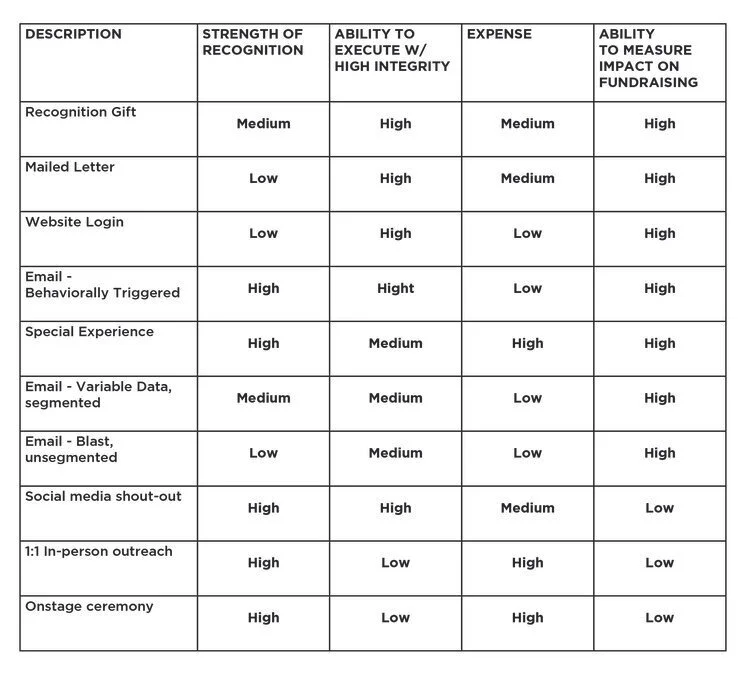Everything Changes - Turnkey Repositions
For the last five years, I’ve been repositioning Turnkey to leave product fulfillment to someone else, for a few reasons.
First and foremost, our team’s highest and best use is to help nonprofits raise more money to serve their mission. While product can serve that effort, product cannot lead that effort. Strategy, consultation, and analysis lead that effort and that is where we will focus.
Second, we learned and changed. We have evolved over 30 years of service and are here: The route to long-term value is to recognize supporters for who they are, not what they do. Recognizing what someone does, raising money, volunteering, etc., focuses on short term behaviors. Recognizing people for who they are — environmentalists, caretakers, animal rights advocates, etc. — produces long-term affinity, and ultimately more revenue.
Third, when you’re a hammer, everything looks like a nail. We must explore the full complement of resources available to make use of this incredibly powerful tool — recognition. It was hard for Turnkey staff and our clients to think more broadly when the easy answer was to deliver product the way we always had and just to renew last year’s contract to save everyone time. We ignored new ways to recognize people made possible by technology. And we ignored ways to use recognition that were more powerful but harder to execute.
COVID19, horrible though it is, can be the impetus for nonprofits to make needed and significant changes. Today’s fraught environment could release us to finally change how we recognize supporters as well as change other practices, like the relative percentage of events and activities conducted online versus offline. This is the moment. If not now, when?
In 2017 Otis Fulton and I published our book, Dollar Dash — The Behavioral Economics of Peer-To-Peer Fundraising. On page 82, there is a visual about ways to deliver recognition:
What this graph demonstrates is that we do things because they are easy and measurable, not because they are most effective. What’s most effective? Social media shout-out, 1:1 outreach, onstage ceremonies. What’s easiest to execute? Recognition gift, mailed letter, website login, triggered emails. We all picked easy.
I started Turnkey on October 1, 1989, the day after I got fired from my previous job (a fun story we can laugh about together sometime). I have supplied many organizations with products used for recognition programs for peer-to-peer fundraisers for a long time. We’ve used the same system for decades – make a promise to a fundraiser for a recognition gift which we will send following the event.
All that time, I’ve been studying recognition and how to use it better to motivate volunteer behavior. The depth of my commitment is demonstrated by chasing down and marrying a social psychologist. I am serious. I’ve learned. We’ve learned. Here is where my company and I stand now:
We use product because we’ve always used product. At one point, it was the only thing that we could apply effectively and at scale with a measurable ROI.
Product delivered post-event can have some impact (fostered by ongoing communications to the participant) but is largely about reinforcing the identity of the fundraiser as someone who is “part of the tribe.” This impacts next year’s fundraising. The impact on current year fundraising is identifiable and real, although not significant enough.
Product delivered post-event goes to a participant’s home, unobservable by others in the moment. This means that we miss using a huge driver of behavior – people seeing me, the fundraiser, being recognized for prosocial behavior. It is a 100% private recognition ceremony.
Being recognized is joyful and powerful to future behavior and attachment. Why would we only give joy after the event, and in a manner, no one else can see? Recognition can and should be delivered throughout the event season, and indeed throughout the year.
Many of our constituents expect products as rewards for behaviors like fundraising – but only because we trained them to think that way.
We need to — once and for all — banish the final vestiges of the concept of using items to motivate fundraising. As in, “if you raise $500, we’ll give you a cooler.” Psychologists have demonstrated over and over that this type of relationship is ultimately demotivating to supporters. We pay lip service to move away from “transactionalism,” but we just can’t seem to make the break fully. Turnkey clients have seen the attempt with our recommendations over the last few years to give less and less in the way of product. Now, Turnkey is making the break once and for all with this type of transactional exchange. We will continue to manage the use of product among other methods to leverage the power of recognition. It will be part of a larger picture.
There are ways to use product. How can you know if product is being used to a good end? A mental device we talk about is, “Would I treat my sister that way?” It goes like this: Imagine you ask your sister to come over on Saturday afternoon to help you clean out your garage (I know you wouldn’t do that in COVID-19 world, but just imagine). Would you say, “if you help me for an hour, I’ll give you a Starbuck’s mug, for two hours you’ll get a $25 Target gift certificate, and for three hours a down-filled jacket in your size?” If you would, your relationship with your sister is on pretty shaky ground.
Instead, after the garage was clean, we might give Sis a bottle of wine for being such a great person, for being not just a family member, but for being your special friend. Tell her that the best thing wasn’t getting a clean garage, (great as that was) but that you got to spend time together. Later, she would enjoy the bottle of wine and think of you fondly. You’ve probably told your supporters that they’re a part of your “family.” Why should we treat our supporters any differently than we’d treat our own sister?
Our evolution:
1989: We thought people would raise money to get a product.
2005: We thought we could motivate behaviors that resulted in fundraising by using product as a nudge.
2020: We now know we get the best results when we recognize a supporter for their personal identity; how they think of themselves. When supporters see the mission as being aligned with their identity, they will act to impact the mission through the nonprofit because of who they are. We can do this with various types of recognition, including some newer approaches as well as thoughtfully bestowed products.
You may have made promises regarding gifts to your fundraisers for the 2020 season and into 2021. This can be a transition period. The language about product can change now, setting the stage for a larger change later. The transition can be used to position the next phase, which is how to mobilize fundraisers/volunteers/donors without focusing on product given to them because of something they did but given to celebrate something they are.
We’ve vetted multiple partners to help us. We believe they are best-of-breed at what they do. The list will continue to evolve as new methods, partners, and technologies make themselves known. I promise you that we will be constant in this – we will continue to change and to help you do so. If we recommend a partner, it is because we believe they are the best for your situation right now.
Our formal partners as of May 2020:
Halo – There is a place for product, positioned carefully for maximum effect to recognize your constituents for who they are — caring and good people.
GoodUnited – You have to deliver recognition inside Facebook, as well as to conduct the rest of your relationship there, and even inside Messenger. Instagram too. And in other platforms that foster community. Yes, really.
Revunami – Acquisition and nurturing through social media. Email isn’t dead, but it did turn into something akin to postal registered mail. When you send an email, you email with those you already know.
Charity Dynamics – Your fundraising and organizational websites are critical. They need to be good. And, new digital tools to supplement your outreach and contact are critical as well.
Institute for Sustainable Philanthropy – These folks from the UK are partners in the science of how to use words. Their study of giving is ground-breaking and quantifies what happens when you recognize someone for who they are, not what they do. They have doubled response rates in direct response campaigns and their methods can do the same for other types of fundraising.
CommonThread – You know being asked to be a volunteer leader is the greatest form of respect and recognition, but you haven’t been able to give volunteer committees and field staff the tools for success, for collaboration. Now you can.
CallHub – It's really all about the cellphones in everyone’s hands right now. For the moment, texts get in front of the eyes. While proving a revenue ROI is still tough, phone-in-hand means texts get through.
Fundraising Platforms – Turnkey understands and supports the work of many fundraising platform providers and those who vet and implement platforms. No one platform is right for everyone and we’re lucky to have high competition, high choice, and high quality in this market.
Our latest Benchmark Report, released today, reflects the way we think about fundraiser metrics. You’ll see that we use fundraiser behaviors to measure engagement. Measuring behaviors provides data to make informed decisions as we redesign our programs.
Turnkey exists solely to help mission-driven organizations make good friendships that last a long time. We are a strategy company serving nonprofits in acquiring and nurturing constituent relationships that culminate in sustainable revenue.
We can’t wait to help.


